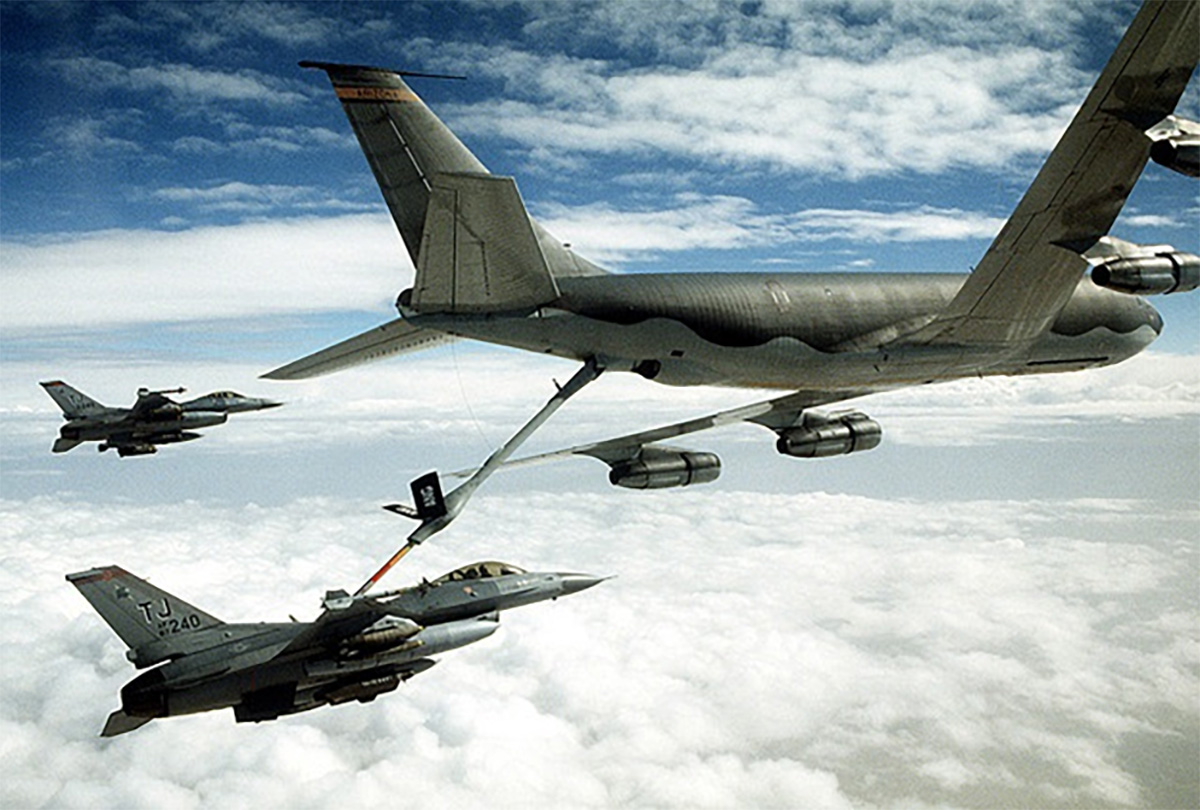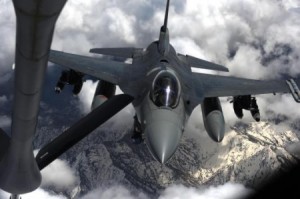Flight Control Failure in the Mountains

Christopher Columbus did it in nine weeks. Lindbergh did it in only 33 and 1/2 hours. I would do it in eight, from South Carolina to Spain.
I was a brand new wingman at Shaw flying my dream jet, the Block 50 F-16 Fighting Falcon, The Viper. I quickly got Mission Ready and was fully checked out for war. My Squadron, the 55th Fighter Squadron was deploying to Turkey for Operation Northern Watch (ONW). Tensions with Iraq were growing since 9-11. Dick Cheney had that look in his eye. We had eight fighters going to ONW and we would most likely be there for the start of the war. This was amazing. I had watched Desert Storm on TV when I was fifteen years old. I couldn’t believe I was going to go fight over Iraq now. I felt like I had won the lottery. Now, don’t get me wrong, war is horrible. To quote John Stuart Mill:“War is an ugly thing, but not the ugliest of things. The decayed and degraded state of moral and patriotic feeling which thinks that nothing is worth war is much worse. The person who has nothing for which he is willing to fight, nothing which is more important than his own personal safety, is a miserable creature and has no chance of being free unless made and kept so by the exertions of better men than himself.”While war is terrible for most involved, I must confess, I love the work. There are bad guys out there. Someone needs to make them go away from time to time to make good people safe. Saddam Hussein was a bad man. He hurt, tortured and killed thousands of innocent people in Iraq. I was looking forward to being on the leading edge of the invasion to kill him and topple his corrupt regime. The day before the deployment we had a briefing at noon. This covered our route, expected weather, our tankers and our divert bases. Nothing sharpens the concentration like being in a single-seat single-engine fighter over the North Atlantic and have an engine or fuel problem. Sometimes our divert airfields were as far away as two hours. After the briefing, I collected my charts and approach plates and went to my Life Support locker and packed everything for the trip. At 1 P.M., was finished at the squadron and went home to sleep. I took an Ambien and slept until midnight. At midnight I got up with the jitters. Lots of thoughts going through my mind…air refueling, keeping track of diverts, and above all, staying awake! I got to the squadron and had a quick ten minute brief on the updated tanker plan and the weather. Since I was a brand new wingman, I would be flying number 2 of 8. Six airplanes had to go in our tanker cell (formation.) We had two air spares. If any jet couldn’t go due to maintenance difficulties, or not being able to take on fuel, the air spare would replace him. I was a bit worried about air refueling. It had been about nine months since my last air refueling, in fact, this would be my fourth time ever doing it. Tonight time I was outfitted in a flight suit, poopy suit (a SCUBA dry suit – to protect us from the cold water temperatures should we eject), survival vest and parachute harness with a life preserver. I felt like the Michelin man. Shortly after midnight I suited up. I gathered my bags and loaded them into the bomb shaped baggage pod on the wing of the jet. I went back inside to wait for our final words on weather, tankers and alternates. At an hour prior to takeoff, I stepped to the jet. This was it, I was going to war. The emotions were intense. I got strapped in and attempted to organize my cockpit of a quarter-planets worth of charts, food and water. Literally you had piles of charts on both aft switch panels. I arranged my water bottles on the air conditioning vents to keep them cold. At 1 A.M. it was dark and pouring rain. The cockpit was soaked! As I was starting the jet I kept wondering how flipping soaking wet switches and high voltage electricity would mix. Once I started the engine and my electrics were all online, I noticed the Data Entry Display (DED) was bad. It was displaying a checkerboard and I couldn’t read any of the information needed to navigate or tune the radios. This display was crucial for setting radio frequencies, entering steer-points, basically any data I needed to give the jet. I didn’t want to try to step to the spare aircraft. For one thing, it was pouring rain and I would need to unpack the entire cockpit and baggage pod. For another, I was so inexperienced, I didn’t know if I could make it there in time and get airborne for the launch. I called avionics and told them of my problem. The tech came out to the jet and told me I would need to shut down and open the canopy. It was raining cats and dogs. I couldn’t imagine my jet soaked to the core. I asked him if I could do anything. He said: “yes, pull the cannon plug behind your right elbow.” I looked at it. There was no way to twist and grip the plug unless I unstrapped. Unstrapping and strapping back in with the canopy closed was quite a chore in all that gear, but that’s exactly what I had to do. When I got a grip on the plug, I rotated it and saw power was off, then I reset it and power was restored. It worked! I now had a good jet and re-strapped in. The DED was alive and functional, I was going to war!! Thanks to a generous time between stepping to the jet and starting, I was ready on time. Our air refueling tanker was already airborne and on its way to meet us above North Carolina. We took off in twenty second intervals. I followed my squadron commander, number one of the eight ship, as number two. He told me in the brief, “Clam, I know you haven’t refueled in a long time, if you can’t take gas, we will just take a spare jet and send you home.” I wasn’t going to let that happen! The pressure was on to take gas. Tonight, it was dark, rainy and cold. At 17,000’ on departure I started seeing some ice and Saint Elmo’s Fire. Instead of a terrible 80’s movie, this was static electricity building up on my canopy due to the rain and ice. Sometimes in the F-16 it will create a miniature lightning bolt that will come into the cockpit and give the pilot quite a jolt. I lowered my seat and tried to be smaller to avoid the tiny lightening. One struck my Heads Up Display (HUD) and shut it down for a minute or two. Approaching the tanker I did not see it. Our regulations require that we see the tanker at 1,000 feet to rejoin. My squadron commander came over the radio and said “Clam, keep rejoining via radar, you should see the tanker at 300 feet.” I was a bit surprised but pressed ahead with the rejoin and rejoined based off the radar lock I had on the tanker. Sure enough, at 300 feet I started to see some lights. I could see my commander was on the boom taking gas. The plan was each of us would get 1,000 pounds (of 12,000 onboard) just to see if our refueling system was working. Once six jets got gas, we would send the two air spares who were hanging out two miles back home if we were all good. This also meant, if I couldn’t stay in position and refuel, I would be sent home and a spare would take my place. I would miss the war.
 As I approached the KC-135 tanker, my flight lead was already done with his 1,000 lbs and was on the tanker’s left wing. I went straight in for fuel. We were still in the clouds and turbulence as I got close. I approached the boom and was immediately connected, then disconnected. I fell off the boom. In the fighter world, this already meant I owed a case of beer on landing for falling off the boom. I tried again. I fell off again. Great, now I owe two cases. My commander then asked our spares their gas. In his planning, he had to have me get fuel before we all got too far from home to return with our gas. We were almost to Virginia at this point. I got on again and did a terrible job of keeping position. The boom operator on the tanker was a grisly old veteran and kept me hooked up despite the turbulence. I got 800 pounds of fuel before falling off again. He knew I needed 1,000 pounds and called on the radio, “good job two, you got one thousand pounds.” Relieved, I moved to the right wing and waited as each other jet took some gas.
Once we all took some gas, the flight lead cleared the other two spare jets off, and I was on my way to The Middle East. The time was 3 a.m. on the east coast.
To be continued…
As I approached the KC-135 tanker, my flight lead was already done with his 1,000 lbs and was on the tanker’s left wing. I went straight in for fuel. We were still in the clouds and turbulence as I got close. I approached the boom and was immediately connected, then disconnected. I fell off the boom. In the fighter world, this already meant I owed a case of beer on landing for falling off the boom. I tried again. I fell off again. Great, now I owe two cases. My commander then asked our spares their gas. In his planning, he had to have me get fuel before we all got too far from home to return with our gas. We were almost to Virginia at this point. I got on again and did a terrible job of keeping position. The boom operator on the tanker was a grisly old veteran and kept me hooked up despite the turbulence. I got 800 pounds of fuel before falling off again. He knew I needed 1,000 pounds and called on the radio, “good job two, you got one thousand pounds.” Relieved, I moved to the right wing and waited as each other jet took some gas.
Once we all took some gas, the flight lead cleared the other two spare jets off, and I was on my way to The Middle East. The time was 3 a.m. on the east coast.
To be continued…
Related posts







